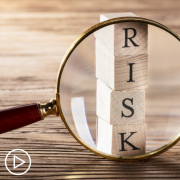Tag Archive for: AML treatment
Does Maintenance Therapy Have a Role in AML Care?
Does Maintenance Therapy Have a Role in AML Care? from Patient Empowerment Network on Vimeo.
Acute myeloid leukemia (AML) expert Dr. Farhad Ravandi-Kashani discusses the role of new and developing maintenance therapies that may improve remission and how this treatment phase may fit into the future of AML care.
Dr. Farhad Ravandi-Kashani is professor of medicine and Chief of the Section of Developmental Therapeutics in the Department of Leukemia at The University of Texas MD Anderson Cancer Center in Houston, TX. Learn more about Dr. Ravandi-Kashani.
Related Resources:

|
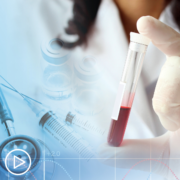
|

|
Transcript:
Laura Beth:
Dr. Ravandi, does maintenance therapy have a role in AML?
Dr. Ravandi:
Maintenance therapy is something that has been used in other leukemias for a long time, and other types of cancer, particularly in ontological cancers. In AML, it hasn’t been normal practice, traditionally, mainly because in AML, we haven’t had many good relatively nontoxic, easily taken drugs.
So, about 30 years ago, some groups, for example, a German group actually tried to do maintenance with cycles of chemotherapy, and you can imagine if a patient is in remission, and somebody says to you, “I’m going to give you cycles of chemotherapy for the next three years,” most patients wouldn’t take it because they say, “Well, you know, maybe I have three years to live. I want to go to Bahamas and be on the beach rather than getting cycles of chemotherapy.” But over the last several years, in a number of effective, highly effective oral agents that have been developed, and one specific agent that has been developed for maintenance. Now, this specific agent is not curative, as it’s not that if you take it, you will live forever.
But it does improve survival, and it’s relatively well-tolerated. And there are other clinical trials of maintenance. Agents are being developed, and I think it’s a very important area in AML. And I think in the next several years, it will actually become common practice to do maintenance regimens.
Laura Beth:
That’s good news. So, once an AML patient is in remission how are they monitored?
Dr. Ravandi:
So, I mean, I usually tell my patients that once you’re in remission, you’re in remission until something goes wrong with your blood counts. So, in my opinion, it’s not important to do – definitely not important to do weekly blood counts, for example.
Depending on patient’s anxiety levels and comfort, we do check their labs maybe once a month, once every two or three months, depending on how far they are from their remission. And in my opinion, routine bone marrows are not necessary during remission, unless the patient is a part of a clinical trial that they have accepted to participated in, because we do get a lot of information by doing those bone marrows. So, some studies have follow-up bone marrows, but that’s really as a part of a clinical trial and to help further the knowledge in therapy.
How Does the Presence of Molecular Markers Affect AML Care?
How Does the Presence of Molecular Markers Affect AML Care? from Patient Empowerment Network on Vimeo.
Dr. Farhad Ravandi-Kashani reviews how the presence of gene mutations can influence acute myeloid leukemia (AML) treatment choices and discusses new molecular markers being researched for future AML care.
Dr. Farhad Ravandi-Kashani is professor of medicine and Chief of the Section of Developmental Therapeutics in the Department of Leukemia at The University of Texas MD Anderson Cancer Center in Houston, TX. Learn more about Dr. Ravandi-Kashani.
Related Resources:

|

|

|
Transcript:
Laura Beth:
How do test results impact AML care and treatment decisions?
Dr. Ravandi:
So, in the first place, the presence or absence of certain mutations can be predictable outcome. Some subsets of leukemias are, for the lack of a better term, more favorable.
I personally don’t think there is anything favorable about any leukemia, but some are easier to treat, and some are easier to cure than others. There is one specific subtype called acute promyelocytic leukemia that we actually completely treat differently. We don’t use even chemotherapy in that subset of leukemia.
It has almost 100 percent success rate. And the treatment of other subsets can also be tailored, depending on these molecular and chromosomal changes. So, the initial therapy can be actually changed. There are now, for example, targeted agents that can be added to the chemotherapy, during initial chemotherapy.
And also, once the patient is in remission, depending on favorable or unfavorable their leukemia is, they may be offered allogeneic stem cell transplant. So, yes, this information is highly important. In fact, I would say crucial for our decision-making in leukemia therapy these days.
Laura Beth:
So, what is new in AML research related to molecular markers?
Dr. Ravandi:
Well, it depends on your definition of new, but FLT3 mutations are very important because they’re now several FLT3 inhibitors, and as I mentioned, the initial therapies are different, to some extent. The IDH mutations are very important, again, because they are specific targeted agents.
TP53 mutations are important because, unfortunately, they are particularly unfavorable.
This is completely hot off the press, but there are subsets of AML called MLL rearranged leukemias that can respond to these drugs called Menin inhibitors.
There are other mutations that have been discovered, many other ones, that there are no specific treatments for at the moment, but there’s a lot of research on.
Managing Your Oral AML Treatment | Tips for Staying on Schedule
Managing Your Oral AML Treatment | Tips for Staying on Schedule from Patient Empowerment Network on Vimeo.
With oral AML therapies becoming more available, patients now play a role in administering their own treatment. Dr. Eytan Stein shares tips for patients managing their at-home treatment regimens.
Dr. Eytan Stein is a hematologist oncologist at Memorial Sloan Kettering Cancer Center and serves as Director of the Program for Drug Development in Leukemia in Division of Hematologic Malignancies. Learn more about Dr. Stein, here.
Related Resources:

|

|

|
Transcript:
Katherine Banwell:
With more oral therapies becoming available, patients now have a role in self-administering their treatment. So, what happens if a patient forgets to take a medication? Does that impact its effectiveness?
Dr. Eytan Stein:
The easy answer to that question is probably not. You know, if you forget to take a medication for three weeks, that’s not a good thing, but if there’s a – you know, this happens all the time, right?
You’re busy, and you just forget. If you forget to take a medication one night or one day, it almost certainly is not going to make a huge difference. Having said that, you shouldn’t see that as license to not be careful. So, it is important to try. So, set an alarm; put out a pill container do the kinds of things that can help you.
The other thing, there is a certain what I would call pill fatigue that sets in. Often, patients with AML are taking multiple medications at multiple times a day, and it can be hard. And at my center, we have pharmacists who do a lot of different things, but one of the things they can help with is sort of streamlining patients’ pill burden to make it easier for them to remember and to take the medications when they’re supposed to take them.
Katherine Banwell:
When a patient does forget to take a dose or even a couple of days’ doses, should they call their healthcare team and let them know?
Dr. Eytan Stein:
Yes, always call. Always call.
Disease Monitoring: Is My AML Treatment Working?
Disease Monitoring: Is My AML Treatment Working? from Patient Empowerment Network on Vimeo.
Dr. Eytan Stein explains how AML treatment effectiveness is monitored and why it’s essential for patients to report any symptoms or side effects to their healthcare team.
Dr. Eytan Stein is a hematologist oncologist at Memorial Sloan Kettering Cancer Center and serves as Director of the Program for Drug Development in Leukemia in Division of Hematologic Malignancies. Learn more about Dr. Stein, here.
Related Resources:

|

|

|
Transcript:
Katherine Banwell:
Once treatment has begun, Dr. Stein, how do you know if it’s working?
Dr. Eytan Stein:
So, that’s a good question. So, the good thing about acute myeloid leukemia when it comes to understanding what’s going on, you know, it’s a disease of the bone marrow cells. And we do bone marrow biopsies to see how things are doing. But no one likes a bone marrow biopsy. It can be a somewhat uncomfortable procedure.
Katherine Banwell:
How often would a patient need to have a biopsy?
Dr. Eytan Stein:
Yeah, so they have bone marrow biopsies at diagnosis, and then they often will have bone marrow biopsies two weeks to a month later.
And then, if they’re in remission, basically any time you think if you want to check to see if they’re in remission or if you suspect the patient is relapsing. Then, you would do a bone marrow biopsy. But what I was getting at is that but you have blood. And the blood is kind of like the bellwether of what’s going on in the bone marrow.
So, the analogy I use for my patients is, you know, when you’re driving your car and you have – you know, you don’t open the hood every day to make sure the car is running okay. You know, you’re driving your car, and if your car starts making a funny clinking sound, that’s when you open the hood.
So, the blood is like the clinking sound. If you see something going wrong in the blood, that’s when you know you’ve got to open the hood and look under the hood. If the car is running just fine and you don’t see anything wrong in the blood, using the analogy, maybe you don’t need to do a bone marrow biopsy.
Katherine Banwell:
What if a treatment isn’t working? What if it stops working or if the patient relapses? What do you do then?
Dr. Eytan Stein:
Yeah, so when a patient relapses, which unfortunately happens more than we want it to, it’s important number one to do another bone marrow biopsy and at that point, do that mutational testing again because the mutations that are present at the time of diagnosis are not necessarily going to be present at the time of relapse, and sometimes, a new mutation might occur at the time of relapse.
And again, what that mutational profile shows can help determine what the next best treatment for the patient is. There might be standard-of-care therapies. More chemotherapy might be recommended.
When a patient relapses, I usually – excuse me – try to get them on a clinical trial because that’s the point where I think clinical trial drugs really have potentially major benefit for the patients, to help get them back into remission.
How Do Gene Mutations Affect AML Treatment Choices?
How Do Gene Mutations Affect AML Treatment Choices? from Patient Empowerment Network on Vimeo.
Dr. Eytan Stein shares why AML patients should undergo molecular testing when choosing a treatment approach, explaining how targeted therapy works to treat AML patients who have specific genetic mutations.
Dr. Eytan Stein is a hematologist oncologist at Memorial Sloan Kettering Cancer Center and serves as Director of the Program for Drug Development in Leukemia in Division of Hematologic Malignancies. Learn more about Dr. Stein, here.
Related Resources:

|
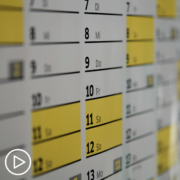
|

|
Transcript:
Katherine Banwell:
Why is identification of genetic markers essential before choosing treatment?
Dr. Eytan Stein:
Because when you know the genetic markers, you can target the genetic abnormalities, sometimes with specific targeted therapies, with therapies that fit like a key in a specific lock.
And those targeted therapies have been shown, in some cases, to improve the survival of the patients, without much cost, without much toxicity. So, I’ll give you an example of this.
There is a very common genetic abnormality in patients with acute myeloid leukemia called the FLT3 or FLT3 mutation. When you have that mutation, there is a targeted therapy that targets the FLT3 mutation called midostaurin (Rydapt), and it’s been shown in a very large clinical trial that the addition of the targeted FLT3 inhibitor midostaurin in combination with chemotherapy leads to better overall survival than chemotherapy alone.
So, you need to know that information because you want to give your patient the best chance at beating the disease. And that’s why it’s also important to try to get this information back quickly. You know, no one wants to be sitting around waiting for four weeks to find out if they’ve got a specific mutation. And we’ve gotten better. I think medical centers generally have gotten better at getting this mutational information back to their doctors relatively quickly.
Katherine Banwell:
Does every patient get this standard testing?
Dr. Eytan Stein:
It is – does everyone get it? I don’t know. But “Should everyone get it?” is, I think, the important question. Yes, everyone should get this testing.
It is incorporated into the NCCN and National Comprehensive Cancer Network and European Leukemia Net guidelines. It is important not only because you can think about targeted therapies, but it is also important for prognostic reasons, meaning that certain mutations lead to a higher risk of relapse, and those mutations in a patient might lead me to recommend a stem cell transplant, which is sort of the most intensive thing we can do to help prevent a relapse, while other mutations, which might be “favorable”, in quotes, they might lead me not to recommend a stem cell transplant.
So, I think this mutational testing is the standard of care and should be done in every patient with newly diagnosed acute myeloid leukemia.
Considerations When Choosing an AML Treatment
Considerations When Choosing an AML Treatment from Patient Empowerment Network on Vimeo.
AML expert Dr. Eytan Stein reviews factors that should be considered when choosing an AML treatment approach, including potential side effects, age, and patient preference.
Dr. Eytan Stein is a hematologist oncologist at Memorial Sloan Kettering Cancer Center and serves as Director of the Program for Drug Development in Leukemia in Division of Hematologic Malignancies. Learn more about Dr. Stein, here.
Related Resources:

|

|
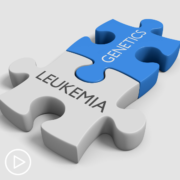
|
Transcript:
Katherine Banwell:
All patients are different, of course, and what might work for one person might not be appropriate for another. How do you choose which treatment is right for a patient?
Dr. Eytan Stein:
So, it’s an individualized decision. So, what you’re talking to the patient, as we talked about at the very beginning, is you really need to understand the patient’s goals for treatment. You need to understand the anticipated benefit of the treatment that you’re offering and need to understand the side effects of the treatment.
So, and that sort of becomes the puzzle that you work with the patient at putting together. That is how well do I expect this treatment to work? What are the potential side effects of the treatment, and what are the patient’s goals? And when you sort of lay all those different pieces out, you then usually come up with something that becomes pretty clear what the best thing to do is.
So, I’ll give you just a very concrete example of this. Sometimes, we have treatments where the medical data would suggest that they might work as well as one another, right? There’s no clear difference between each of the two treatments. But maybe one of the two treatments requires you to be in the hospital, and one of the treatments allows you to be at home.
So, that’s an important discussion to have with the patient because some patients, believe it or not, want to be in the hospital, because they’re worried about being at home and having to manage this all themselves. Some patients don’t want to be in the hospital. Some patients want to be at home, because they’re scared of the hospital, or they’re worried the food’s going to be terrible.
And then, that would be important in helping the patient make the decision for their treatment.
Katherine Banwell:
Right. You mentioned earlier, Dr. Stein, the difference in ages and how you would treat different people depending on their age. So, when you’re choosing a treatment, you obviously look at age. What else? Things like comorbidities?
Dr. Eytan Stein:
Yeah, so age, so I’m not ageist. So, it’s more that as people get older – and this is just a fact of life – as everyone gets older, their organs don’t work quite as well anymore, right? Things start breaking down as you get older. So, certain treatments aren’t appropriate for older people because the treatments a younger person, because their organs are working at 100 percent, may be able to handle it, while an older person, where their organs might only be working at 60, 70 percent, the treatment might not be as good of a choice for them.
So, that’s what I mean. So, as people age, their comorbidities increase. So, we always look at comorbidities, and if you had an 80-year-old that was running marathons, I might think about their treatment differently than an 80-year-old who is not running marathons. But most 80- and 85-year-olds aren’t running marathons, so that’s why we sometimes think about their treatment differently.
What Are Current and Emerging AML Treatment Approaches?
What Are Current and Emerging AML Treatment Approaches? from Patient Empowerment Network on Vimeo.
AML Expert Dr. Eytan Stein provides an overview of current and emerging treatment approaches for people living with AML.
Dr. Eytan Stein is a hematologist oncologist at Memorial Sloan Kettering Cancer Center and serves as Director of the Program for Drug Development in Leukemia in Division of Hematologic Malignancies. Learn more about Dr. Stein, here.
Related Resources:

|

|

|
Transcript:
Katherine Banwell:
What are the treatment types available to AML patients? You mentioned chemotherapy. What else is there?
Dr. Eytan Stein:
Yeah, so if I was having this discussion with you, even when I first started my career back in 2013, all I would’ve been talking to you about was induction chemotherapy and maybe a lower-dose chemotherapy called hypomethylating agents.
I think one thing that really needs to be recognized is that the advances we’ve made for the treatment of acute myeloid leukemia, over the past 10 years, have been just remarkable. We’ve had a number up to nine drug approvals over the past 10 years, and those therapies fall into the following categories.
We now have therapies outside the strong induction consolidation we talked about. We have therapies such as targeted therapies that target specific gene mutations that are present in patients with acute myeloid leukemia. Those are often oral therapies that patients can take at home. And we have very effective therapies for older patients who usually can’t handle the side effects of induction chemotherapy. That’s the combination of a type of drug called a hypomethylating agent with a very, very powerful targeted drug called a BCL-2 inhibitor.
One of those drugs, that drug is called venetoclax. That’s the one that’s FDA-approved. And the combination of those hypomethylating agents and venetoclax, has really changed the paradigm for how we treat older patients with acute myeloid leukemia, led to many patients who have been able to live much longer than they would have before this therapy came about.
You know, there are other therapies that are in development, but I don’t know if we’ll end up talking about that a little bit later. But there are therapies such as immunotherapy, which has gotten a lot of press for other kinds of cancers, like one cancer called the rectal cancer, that aren’t yet approved for acute myeloid leukemia but are being developed for acute myeloid leukemia.
So, the future of acute – the current treatments for acute myeloid leukemia are dramatically better than they were 10 years ago, and I would anticipate that we’re going to continue to see these kind of advances over the next 10 years.
Katherine Banwell:
What about stem cell transplant? Who might be right for that? Who might be eligible?
Dr. Eytan Stein:
Yeah, so let’s go back to the discussion a little bit about consolidation chemotherapy. So, when you have a patient that gets induction chemotherapy or gets any therapy – it doesn’t have to be chemotherapy – to put their disease into remission, for a large group of patients, we think that the best way to cure their disease is to do something called a stem cell transplant.
So, what’s a stem cell transplant? What it is not is like a heart transplant or a liver transplant, which patients often don’t realize.
So, it’s not a procedure where an organ is being transplanted through a surgical procedure. What it is is it’s acknowledging that the cause of acute myeloid leukemia is that the most primitive cells in the bone marrow, called the stem cells, are the cause of the disease. And the chemotherapies that we give patients to get them into remission don’t always eradicate those bad stem cells.
So, what we’re able to do once a patient is in remission is we try to get them new stem cells. How do you get a patient new stem cells? Well, you go to a donor, and there’s a donor bank of people who have volunteered to donate stem cells to patients with acute myeloid leukemia. You go to the donor bank, and then you give chemotherapy to the patient to sort of wipe out their bad stem cells, and then you give them new stem cells that will hopefully permanently eradicate the disease.
What ends up happening is that a large group of patients with acute myeloid leukemia end up being referred for a stem cell transplant. The reason is twofold. You know, it used to be – I keep talking about the past. I’m getting older, and so now I can talk about the past.
Yeah. So, it used to be that stem cell transplants were really reserved to people less than 65 years old.
But our advances in our ability to do stem cell transplants has allowed for us to now successfully do stem cell transplants on patients, even into their upper 70s and sometimes even at the age of 80.
Katherine Banwell:
Where do clinical trials fit in to all of this?
Dr. Eytan Stein:
Ah. So, clinical trials are extraordinarily important for a variety of reasons. Clinical trials are important because the only way we make advances on a societal level in the treatment of acute myeloid leukemia is by patients who are willing to participate in clinical trials. All of the – because these are trials that are testing new therapies with the goal of improving the survival and the quality of life of patients with acute myeloid leukemia. All these drugs I just talked about that have been approved over the past 10 years, they never would’ve been approved if patients hadn’t agreed to participate in clinical trials. So, that’s something that’s number one that’s very important.
But on a – forget the societal level for a second. On a patient-specific level, a clinical trial can potentially benefit a patient because it offers a patient access to a new, exciting therapy that may really help in improving their outcome of having acute myeloid leukemia.
Katherine Banwell:
Yeah. You mentioned emerging therapies. What are some of those?
Dr. Eytan Stein:
Oh, there’s so many. So, it’s hard to talk about all of them, but I think there are targeted therapies – I think if you sort of break them up into sort of broad buckets, there are new targeted therapies that are being developed for subsets of patients with acute myeloid leukemia. One of the ones I’ve been working on pretty heavily over the past few years is a kind of drug called a menin inhibitor. This is an oral medication that is given to patients of acute myeloid leukemia who have certain genetic abnormalities, specifically either a mutation in a gene called NPM1, or a what is called a rearrangement in a gene called MLL.
So, that’s a group of – that menin inhibition seems to be extraordinarily effective in treating patients, at least from the early data, for those specific subtypes of acute leukemia.
The other therapies that are really getting a lot of play now are the immunotherapies, which I mentioned a second ago. There are immunotherapies that work to – called bispecific immunotherapies where what happens is it works to harness the immune system to kill the cancer cells. You may have heard a lot about CAR T-cell therapy, which is another way of harnessing the immune system and engineering immune cells to target acute myeloid leukemia cells. And the other thing I want to point out is that even if you don’t have a new therapy against a new target, you can imagine now that we’ve got all these 10 new approved drugs.
But what we’re trying to figure out – one of the things we’re trying to figure out over the past few years has been what’s the best way to give these new drugs? What kind of combinations can you put them in that might make things even better? Maybe you should give two of those drugs first and then give another drug afterwards. And a lot of the research that’s being done now is being done to understand the best sequencing and combinations of drugs with the drugs that we already have approved.
What Are the Phases of AML Therapy?
What Are the Phases of AML Therapy? from Patient Empowerment Network on Vimeo.
Dr. Eytan Stein discusses the phases of AML treatment, defining induction therapy, consolidation therapy, and maintenance therapy.
Dr. Eytan Stein is a hematologist oncologist at Memorial Sloan Kettering Cancer Center and serves as Director of the Program for Drug Development in Leukemia in Division of Hematologic Malignancies. Learn more about Dr. Stein, here.
Related Resources:

|

|

|
Transcript:
Katherine Banwell:
What is induction therapy?
Dr. Eytan Stein:
Yeah, so induction chemotherapy refers really to a type of chemotherapy that tends to be quite intensive, so strong chemotherapy that patients receive in the hospital setting. That induction chemotherapy typically requires a hospitalization of three to four weeks, sometimes a little bit longer, as the patient gets their treatment during the first week or so and then they’re recovering from the effects of that treatment during the next three weeks in the hospital.
Katherine Banwell:
Okay. What is consolidation therapy?
Dr. Eytan Stein:
Ah. So, a patient first gets induction chemotherapy. If they achieve a complete remission, so their disease goes away, that’s great. We know their disease seems to be gone. But we also know that patients relapse. So, if patients relapse, it means their disease wasn’t really gone. It’s just that we couldn’t find it. It was hiding somewhere.
So, consolidation chemotherapy is chemotherapy that is given after a patient is in complete remission in an effort to kill any residual leukemia cells that may be hiding in the body, that we can’t see in our bone marrow biopsies, in an effort to deepen the remission that we’ve achieved during induction.
Katherine Banwell:
Okay. Are there any other terms that patients should be familiar with?
Dr. Eytan Stein:
There are. You know, there are a lot of other terms that patients should be familiar with. I’ll just touch on one because it can get complicated. We now have for acute myeloid leukemia, a type of therapy that goes beyond induction and consolidation called maintenance therapy.
Maintenance therapy is when a patient is done with induction, done with consolidation, and the question is, can you give them something that is easy to take, relatively non-toxic, that they can take for a prolonged period of time, to also help prevent relapse? Maintenance therapy has been really a backbone of the treatment of a different kind of leukemia called acute lymphoblastic leukemia, which happens primarily in children for many years. Maintenance therapy is also now a backbone of therapy for a different kind of blood cancer called multiple myeloma. And very recently, only within the past year to two years, we’ve incorporated maintenance therapy for AML for certain groups of patients.
Tips for Thriving With AML | Setting Treatment Goals
Tips for Thriving With AML | Setting Treatment Goals from Patient Empowerment Network on Vimeo.
AML expert Dr. Eytan Stein shares how he defines thriving with AML and emphasizes the importance of setting treatment and care goals with your healthcare team.
Dr. Eytan Stein is a hematologist oncologist at Memorial Sloan Kettering Cancer Center and serves as Director of the Program for Drug Development in Leukemia in Division of Hematologic Malignancies. Learn more about Dr. Stein, here.
Related Resources:

|

|

|
Transcript:
Katherine Banwell:
Since this webinar is part of Patient Empowerment Network’s Thrive series, I thought we could start by getting your opinion on what you think it means to thrive with AML.
Dr. Eytan Stein:
Yeah, so thriving with AML I think can mean different things to different people. Thriving with AML can mean when you have the disease, really having the fortitude to get through the treatment that you’re being given because sometimes that can be tough.
And sometimes, it’s not easy. But the people who are thriving are the ones who are able to discuss with their doctors what their treatment is, what the side effects of that treatment might be, how to minimize those side effects, and how to get through that treatment so that not only do they feel better physically but can feel better emotionally and ultimately, hopefully go into a complete remission.
Katherine Banwell:
Thank you for that, Dr. Stein. I think that helps guide us as we continue this conversation. Getting appropriate AML care is part of thriving, and when we consider treatment options, it’s important to understand the goal of treatment. So, how would you define treatment goals for patients?
Dr. Eytan Stein:
Yeah, so the treatment goals for patients really come in different forms. I think fundamentally what everyone wants is everyone wants to go into a complete remission and be cured of their disease. And certainly, that’s an overarching goal that we aim to achieve with our treatments. But there are other goals that I think are important too to various patient populations, depending on what stage of life they’re in.
Are they 85 years old or 90 years old and have lived a long, full life? And their goal might be to improve their blood count so they don’t need transfusions so frequently. And they might be able to go to that grandchild or great-grandchild’s wedding or other life event. There are other patients for whom the goal might be, very discreetly, just to get to that next step in their treatment.
That next step in their treatment might be a bone marrow transplant.
The next step in their treatment might be some more therapy. But I think overall as a doctor, our goal is always to do our best to get our patients into a complete remission and cure them while maintaining the best quality of life for our patients.
Katherine Banwell:
What do you think is the patient’s role in setting treatment goals?
Dr. Eytan Stein:
Well, it’s really important for the doctor to explore the goals of treatment when they first meet with the patient. I don’t think doctors should assume that all patients come into that first visit with the same goals. And what those goals are, I think, may differ a little bit from patient to patient. And it’s really important for the patient to express overtly what their goals are, what they want to achieve from the treatment. You know, I have some patients who come in to me and say, “My goal is to be cured and be alive for the next 30 years” or 40 years or 50 years.
And I have some patients that come into treatment, and they say, “You know what, I have had a very, very long life, and I just want the best quality I can have for as long as I can possibly have it.”
Which Tests Do You Need Before Deciding on an AML Treatment Path?
Which Tests Do You Need Before Deciding on an AML Treatment Path? from Patient Empowerment Network on Vimeo.
Why is it important to ask about biomarker testing for your AML? Find out how test results could reveal more about your AML and may help determine the most effective treatment approach for your individual disease.
Related Resources:

|
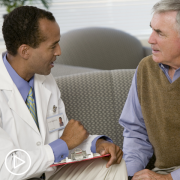
|

|
Transcript:
Why do you need biomarker testing before deciding on a treatment plan for your acute myeloid leukemia—also known as AML?
The results may predict how your AML will behave and could indicate that one type of treatment may be more effective than another.
Biomarker testing—also referred to as risk stratification, genetic testing, or molecular testing—identifies specific gene mutations, proteins, chromosomal abnormalities and/or other molecular changes that are unique to your AML.
The results of these tests are used to determine if you have low-risk or high-risk AML to help guide prognosis and to evaluate the goals of treatment.
There are certain biomarkers—such as the FLT3, IDH1 and IDH2 mutations—that could indicate that your AML may respond well to a targeted therapy. There are several FDA-approved targeted therapies—known as inhibitor therapies—which treat patients with these mutations.
Additionally, the identification of other biomarkers—such as TP53, NPM1, or CEBPA mutations, to name a few—may aid in assessing your prognosis, determining a treatment course, or may identify if an allogeneic stem cell transplant may be appropriate. Results of these tests may also suggest that a clinical trial is your best treatment option.
So, how can you Insist on the best care for YOUR AML?
• First, always bring a friend or a loved one to your appointments to help you process information and to take notes.
• Ask your doctor if you have had, or will receive, biomarker testing and how the results may impact your care and treatment plan. Be sure to ask for paper or electronic copies of your important test results.
• Finally, always speak up and ask questions. It’s important that you understand all of the information that you want to know about your AML to help make the best treatment decisions for you. You are your own best advocate, and treating AML is a team approach.
To learn more about your AML and to access tools for self-advocacy, visit powerfulpatients.org/AML.
Empowered AML Patient: Ask the AML Expert
Empowered AML Patient: Ask the AML Expert from Patient Empowerment Network on Vimeo.
For acute myeloid leukemia (AML) patients, how can they get the best care no matter location? Watch as expert Dr. Catherine Lai and AML patient Sasha Tanori discuss advancements in AML detection and treatments, the use of remote monitoring, questions to ask if you suspect you have AML, how AML can vary by age, and clinical trials access for optimal care.
See More from Best AML Care No Matter Where You Live
Related Resources:

What Treatments Are on the Horizon for Acute Myeloid Leukemia Patients? |
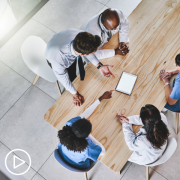
|

|
Transcript:
Sasha Tanori:
I want to start off by saying, thank you so much for joining me, Dr. Lai, I greatly appreciate it.
Dr. Catherine Lai:
Thank you for having me.
Sasha Tanori:
Dr. Lai, early on before my diagnosis, AML, many of my doctors I saw dismissed my symptoms and attributed them to me being plus-sized. Can you share with us how detecting AML has evolved over the last several years?
Dr. Catherine Lai:
Yes, and I’m sorry to hear that, but what I would say about the diagnosis is that how we diagnose patients with AML, unfortunately, hasn’t changed significantly in the sense that we still have to rely on our standard techniques with the bone marrow biopsy. But what I would say is that the technology for how we risk-stratify patients and subsequently treat patients has improved because we have a better understanding of the molecular characteristics of AML now, and so it has helped us in terms of being able to identify more targeted treatments, where patients are more likely to respond and help us with both our short-term and our long-term plan.
Sasha Tanori:
Right, got it. My next question is, can you speak on how monitoring and treating AML has changed during the pandemic?
Dr. Catherine Lai:
Yeah, so unfortunately, as you experience it, you spent your induction in the hospital for several weeks, and when you’re able to be in the hospital with support, either from friends or from family, it makes the experience much, much easier and with COVID, especially at the height of the pandemic, we weren’t allowed our hospital. And I know several of my colleagues as well, the hospitals weren’t allowing any visitors and that put a lot of stress on the patient, on family members, on the staff, the nurses, the physicians, really the whole care team. Just because we were needing to spend extra time to make sure that everybody was updated, so either if we couldn’t do it on FaceTime, having to make sure other phone calls later, which is just…it is what it is. And we made the best of the situation. Currently, we are allowing to have a limited visitor policy, which is helpful. I think the other thing that has really changed is what we consider when we’re starting treatment, if patients obviously need induction chemotherapy and need to be in the hospital, we don’t change the recommendation based on that, but if there are patients who…
Dr. Catherine Lai:
There are options whether or not the patient is done inpatient versus outpatient, I think that that’s a huge consideration in terms of quality of life and how we manage those patients.
Sasha Tanori:
Can you speak to the advances and treatment options for high-risk AML patients?
Dr. Catherine Lai:
Yes, so fortunately, we have made a lot of progress in the AML space, that is one thing that is really exciting, I would say. Since 2017, there have been nine FDA approvals for AML, and prior to 2017, and we have been using the same chemotherapy for the last 40 years. Now, that’s not for lack of trying. There are many leukemia physicians who have been working at this for the duration of their careers, but AML just is very heterogeneous, and it’s very smart. It’s smarter than we are, and it’s constantly changing, and so that has made it challenging in terms of being able to treat it. So, there are newer treatment options, both modifications to traditional chemotherapy as well as other targeted therapies that have improved the landscape for AML and high-risk AML in particular. That’s awesome.
Sasha Tanori:
Dr. Lai, I think another factor that played a role in my diagnosis is somewhat being delayed is my age, I was 24 at the time, what are some questions others who suspect they have AML should ask to rule out the diagnosis?
Dr. Catherine Lai:
So, Sasha, that’s a really good question. And what I would say is that, as you are aware, the median age of AML diagnosis is 68, so not to say that we don’t have young patients…I have plenty of young patients, but it doesn’t come to…it’s not a common thing to think about in younger patients right off the bat, the other thing that contributes to that is also AML compared to other cancers is an uncommon cancer. There are only 25,000 cases of newly diagnosed in the United States per year because it’s not as common in younger patients and because it’s not that common…doctors often want to rule out other simple things rather than just going straight to a cancer diagnosis though, unfortunately, that can lead to some delays, what I would say in young patients who are healthy is that they shouldn’t have low blood counts that can’t be explained for other reasons. So, I think having prompt attention in terms of if their blood counts are abnormal, to really understanding why they’re abnormal, and those are things that can be easily work up, and if all those things are rolled out, then you’re talking about doing a bone marrow biopsy I don’t like to do procedures for unnecessary reasons, but it’s one of those things that you can also…
I mean, I think if you have a physician who is the astute and is thinking about that, that you can…you can get to a diagnosis pretty quickly, I mean AML is a diagnosis in the name acute. It comes on acutely, so that means days to week, so I suspect you are probably feeling very well and over a very short prior of time felt very unwell, and you’re very in tune to your body, and that is very important because patients are smarter than we give them credit for, and so being persistent and knowing that something is wrong goes a long way. Again, I’m sorry that you had to deal with that, and I’m glad that they finally made the right diagnosis, but I think just awareness and education. While it is an uncommon disease, I think having a larger burden and strain that happen on younger patients because you haven’t been working for the majority of your life, and it takes a huge toll on what your potential is, both as a person, but economically and all sorts of things. So it’s a huge problem
Sasha Tanori:
Does prognosis of AML vary by age?
Dr. Catherine Lai:
So, yes and no. So let me answer that in two steps, so it does in the sense that older patients are more likely to have more comorbidities, so more medical problems, and so therefore have a higher likelihood of having complications, and also as patients get older, they acquire more mutations and more abnormality, so those molecular abnormalities, and so therefore, older patients then are become more challenging to treat as well. What I would say though, is that we typically risk-stratify based on molecular factors, so the different mutation than somebody has and the age and the comorbidities don’t necessarily play into that role of stratification, so for example, whether or not you’re receiving a transplant or not…age is a factor, if you’re kind of in that little risk category, the intermediate risk category, the other thing I would say is that for young patients, they are able to tolerate because many don’t have medical problems, so they are able to tolerate treatment better, so when I’m talking about numbers and likelihood of response and overall survival, those…all those mediums assume that somebody is in their mid-60s, and so I adjust the numbers because for younger patients that those numbers are likely higher…
Because they’re less likely to have complications.
Sasha Tanori:
Right. I had many medical professionals that participated early on in my care. Can you speak on the role of the multidisciplinary care team that plays in AML care?
Dr. Catherine Lai:
Yeah, this is…this is an excellent question. I would say that treating leukemia is a team sport, everybody has their role, and it’s not just one person, and this is part of why I love treating leukemia patients, is that we’re able to engage multiple players, everybody is good at their particular thing, and so one analogy is that…we’re kind of like a baseball team, is that you want everybody to be able to do their own…have their own position. What a standard for our center is that we have the leukemia physician, there’s a specific leukemia nurse, we engage our social worker very early on, and also our cancer nutritionists and physical therapist and occupational therapist so we all work together at different parts of the treatment journey to make sure the patient is getting everything that they need and the whole person is being taken care of.
Sasha Tanori:
Right. AML patients, just like anyone else, want to live and live a very long time. Are AML patients at risk for secondary cancers, and are there any studies that speak on this?
Dr. Catherine Lai:
Yeah, so I would say everything has its risk and benefits at the time of diagnosis, you need the chemotherapy in order to get into remission, and then if you need the transplant, whether or not you’re getting radiation and then further some chemotherapy before the transplant, so that’s not without risks, so especially in a young patient, for example, in your particular case, you’re at risk for secondary treatment-related MDS and other bone marrow-related disorders that could occur, most patients who are in their 60s who, if they live long enough would be at risk, but most of those patients will die of something else before you have that opportunity. As a young patient, the other thing to be aware of, especially with, given that you’ve had transplant, is that the increased risk of cardiovascular effects, as well as making sure in patients who have had your whole-body radiation, other effects in terms of their thyroid, lung function, and then screening earlier for other cancers. So in terms of looking at studies, we know that these risks are slightly increased and that monitoring starts a lot sooner, especially in young patients. So I think just being aware of what you need to do.
Dr. Catherine Lai:
We also have a survivorship clinic, which I think is really important to help understand, you know what your risks are, because once your leukemia is in remission, we don’t want you to develop other medical problems, so it’s important just for patients to be educated so that they know how to take care of their body at each stage of their…again, of their journey.
Sasha Tanori:
Alrighty, after getting a bone marrow transplant three years later, I’m still dealing with graft-versus-host disease or GVHD, but there are other obstacles that I’m also facing. Does GVHD ever truly go away or is it something that I’m going to have to learn to live with?
Dr. Catherine Lai:
Yeah, I wish I had a magic answer for you. Our data is that it gives us guidance for each patient, but then also each patient as an individual and how they respond to different medications, and the nuances of that is…it can be different. So what I would say is that there are patients who you have chronic GVHD for years and it can eventually go away, and in some patients, they deal with it for a lifetime, you’re young enough, and I’m hopeful enough that at some point it will improve and get better. So I would be cautiously optimistic that things will improve.
Sasha Tanori:
I’m…I’m trying my best.
Dr. Catherine Lai:
It’s hard.
Sasha Tanori:
Yes, it’s very hard. Yeah, my care team suggested a clinical trial for a new drug focusing on improving my lung function, fortunately, my lungs improved on their own. Dr. Lai, not every AML patient is offered clinical trial as a care option, what advice you have for AML patients who are seeking clinical trial and what’s the best way to locate one?
Dr. Catherine Lai:
Yeah, so this is an area, a huge area of unmet need, I would say in general, across all oncology trials, and I think less than 10 percent of the patient population is on trials, there’s a lot of stigmas around clinical trials and are you getting… Are you getting a drug that we don’t know what’s gonna work, am I being…am I being tested? In oncology, I would say for the most part, we try to make trials where you’re being measured to the standard, so you’re getting the standard plus, or we’re trying not to…just in terms of doing what’s best for the patient, in general, I don’t offer trials to patients where I don’t think that there’s scientifically a rationale for those drugs, but to answer your question, the best place to look is on clinicaltrials.gov. That’s cumbersome. If you don’t know what you’re looking for, I can give you a lot of unnecessary information. There are a lot of other resources out there, The Leukemia & Lymphoma Society is a great resource. I know that they have online or people that you can talk to in terms of helping you direct specific clinical trials, I know depending on where you live in the country, there are other local New Chapters, oncology chapters that we have that can help patients find…
And have access to clinical trials, and then I think the biggest thing is just if a patient is with the community oncologist, having enough education to say, can I have a referral to an academic institution where they can ask those questions and get that information, and local community oncologists are fantastic, but they see everything, they see breast cancer, they see one cancer where the academic centers were specialized where all I see is leukemia and MDS kind of acute leukemias. So it’s just a different set of knowledge.
Sasha Tanori:
Okay, my next question is, I’ve had one telemedicine visit via my online portal, is the role of the telemedicine in AML care becoming more important?
Dr. Catherine Lai:
Yes, so what I would say…so this is my personal opinion, but in my opinion, that medicine compared to other industries tends to be a little bit farther behind, we’re not as quick to adapt the newest technology where COVID has helped, I think is at least in my practices, help utilize telehealth in the sense that there was a period of time where I was seeing fewer patients and then it really picked up because especially for patients who have a local oncologist but want a second opinion, the telehealth really offers that they don’t have to travel two hours to come see me to get that opinion. So what I would say is that it cannot replace the physical exam, it can’t replace a face-to-face discussion when you’re really talking about new diagnosis and therapy, because I really do think that that should be in person, but where… I have found that it’s been really helpful is if I’ve had an initial visit with the patient, and they either have a local oncologist, so I’m just checking in with them periodically, or if it’s to review results, say they’ve had a bone marrow biopsy and it’s…
They’re further along in their treatment, or if they’re just reviewing imaging results or something where I don’t necessarily need to see them have a physical exam and I’ve seen them recently, and so I do everything else that’s going on, but can I check in to review a specific part of information. I think that telehealth would have a role, and I hope it continues to have a role.
Sasha Tanori:
Yeah, yeah definitely, I agree. It’s really helpful in that sort of way, so you don’t have to actually leave the comfort of her home for something that’s not really super serious. You know?
Dr. Catherine Lai:
Exactly, yeah, I think what happens is patients do tend to…what I’ve noticed patients do is under-report, so it’s for… Not for infrequent visits, so for patients who are followed on a regular basis, it does allow there to be some ease of burden in terms of how we treat our patients.
Sasha Tanori:
Right. So a silent side effect that people facing cancer don’t always talk about is mental health. Are there any treatments or coping methods that you recommend for patients and care partners?
Dr. Catherine Lai:
Yeah, so I would say to get social work involved early on, I think there’s also…it’s silent, ’cause there’s a lot of stigma around it, is that is something that we should be talking about or not talking about or…I can handle it, that sort of thing, so I introduce our social worker very early to know that she is a resource for the patients, no matter how big or how small, just to try to get them used to that idea. What I would also say is just talking with as many people as possible as I’m sure you realize that the network and the community is small and everybody is willing to help each other out, so once you put yourself out there, you’ll realize that there are other resources out there, and you’re not alone in this journey, and what your cancer team offers you is different than what other patients who have gone through exactly what you’ve gone through can offer, and so I know that there are other resources out there in terms of societies that connect other patients who have the same diagnosis, so I would say it’s really just about education and talking and knowing that it’s okay to talk about your diagnosis and no matter what format that is, or if it’s a little bit now and a little bit later, and also just normalizing it, in the sense of the feelings you have are valid and normal, and if you don’t have those feelings is actually when I get worried about patients because you’re supposed to have certain reactions, you were a young patient and you were diagnosed with cancer.
That’s not a trivial thing. And we’re just…we’re all here to help you and help the patients go through everything…
Sasha Tanori:
So for my last question is the future bright in AML treatment and can you speak about any exciting studies that you are working on, that AML patients and their families should stay tuned for?
Dr. Catherine Lai:
Yes, so I am excited. I am excited to say that I think in my lifetime, I will be a part of AML change and we have already seen it. I have mentors who are in their 60s, who have used the same therapies, they use them for the entirety of their career. And so as I mentioned, we only have your 9 FDA approvals. I think there are more coming… I think what I would like to mention is I think the use of immunotherapy, bone marrow transplant is the original immunotherapy, but as you know, there are many risks and benefits and complications, and so how we manipulate the immune system or how we use drugs to help manipulate the immune system, I think it’s a work in progress. It has been more successful in other cancers, not as successful in AML yet, but I think we will get there. The other thing would be, is how… We look at minimal residual disease. So, as you know, but for everybody else, we consider a complete remission is less than anything less than 5 percent blast or 5 percent leukemia cells but we know that anything greater than zero is bad, and you have more than zero, the disease will come back at some point.
So looking to how we monitor, going back to those molecular technologies and how we’re monitoring for residual disease so that we can detect disease faster, so I think really the concept of detection and prevention will come into a huge role because also if we can detect the disease relapse sooner, we’re treating less disease and then there’s less side effects and less toxicity, and then I think the last thing would be health outcomes of a lot of what we’ve been talking about just in terms of the whole picture and how we can better treat these patients I also think there’s a huge role for looking at each individual person and their age and their medical problems, and they’re a physiologic age as opposed to their chronological age and how we can best treat the patient so they can have the best outcome.
Sasha Tanori:
All right, well, thank you so much, Dr. Lai, for taking the time to speak with me and for all you’ve done for the AML community and our patient’s families, everyone.
Dr. Catherine Lai:
Thank you, thank you so much for having me. I’ve really appreciated you putting yourself out there… Thank you.
What Treatments Are on the Horizon for Acute Myeloid Leukemia Patients?
What Treatments Are on the Horizon for Acute Myeloid Leukemia Patients? from Patient Empowerment Network on Vimeo.
What can acute myeloid leukemia (AML) patients expect in the future of AML studies? Watch as expert Dr. Catherine Lai shares insight about the state of FDA approvals. what is in pipeline for AML treatment, and disease monitoring technologies for improved patient care.
See More from Best AML Care No Matter Where You Live
Related Resources:
Transcript:
Sasha Tanori:
Is the future bright in AML treatment, and can you speak about any exciting studies that you are working on, that AML patients and their families should stay tuned for?
Dr. Catherine Lai:
Yes, so I am excited. I am excited to say that I think in my lifetime, I will be a part of AML change and we have already seen it. I have mentors who are in their 60s, who have used the same therapies, they use them for the entirety of their career. And so, as I mentioned, we only have your nine FDA approvals. I think there are more coming…I think what I would like to mention is I think the use of immunotherapy, bone marrow transplant is the original immunotherapy, but as you know, there are many risks and benefits and complications. And so how we manipulate the immune system or how we use drugs to help manipulate the immune system, I think it’s a work in progress. It has been more successful in other cancers, not as successful in AML yet, but I think we will get there. The other thing would be, is how…we look at minimal residual disease. So, as you know, but for everybody else, we consider a complete remission is less than anything less than 5 percent blast or 5 percent leukemia cells but we know that anything greater than zero is bad, and you have more than zero, the disease will come back at some point.
So looking to how we monitor, going back to those molecular technologies and how we’re monitoring for residual disease so that we can detect disease faster, so I think really the concept of detection and prevention will come into a huge role because also if we can detect the disease relapse sooner, we’re treating less disease and then there’s less side effects and less toxicity, and then I think the last thing would be health outcomes of a lot of what we’ve been talking about just in terms of the whole picture and how we can better treat these patients I also think there’s a huge role for looking at each individual person and their age and their medical problems, and they’re a physiologic age as opposed to their chronological age and how we can best treat the patient so they can have the best outcome.
Advice for Acute Myeloid Leukemia Patients Seeking a Clinical Trial
Advice for Acute Myeloid Leukemia Patients Seeking a Clinical Trial from Patient Empowerment Network on Vimeo.
Where can acute myeloid leukemia (AML) patients find information about clinical trials? Watch as expert Dr. Catherine Lai shares clinical trial resources and details about the clinical trials process in patient care.
See More from Best AML Care No Matter Where You Live
Related Resources:
Transcript:
Sasha Tanori:
My care team suggested a clinical trial for a new drug focusing on improving my lung function, fortunately, my lungs improved on their own. Dr. Lai, not every AML patient is offered a clinical trial as a care option, what advice do you have for AML patients who are seeking clinical trials, and what’s the best way to locate one?
Dr. Catherine Lai:
Yeah, so this is an area, a huge area of unmet need, I would say in general, across all oncology trials, and I think less than 10 percent of the patient population is on trials, there’s a lot of stigmas around clinical trials and are you getting…are you getting a drug that we don’t know what’s going to work, am I being…am I being tested? In oncology, I would say for the most part, we try to make trials where you’re being measured to the standard, so you’re getting the standard plus, or we’re trying not to…just in terms of doing what’s best for the patient, in general, I don’t offer trials to patients where I don’t think that there’s scientifically a rationale for those drugs, but to answer your question, the best place to look is on clinicaltrials.gov. That’s cumbersome. If you don’t know what you’re looking for, I can give you a lot of unnecessary information. There are a lot of other resources out there, The Leukemia & Lymphoma Society is a great resource. I know that they have online or people that you can talk to in terms of helping you direct specific clinical trials, I know depending on where you live in the country, there are other local new chapters, oncology chapters that we have that can help patients find…
And have access to clinical trials, and then I think the biggest thing is just if a patient is with the community oncologist, having enough education to say, can I have a referral to an academic institution where they can ask those questions and get that information, and local community oncologists are fantastic, but they see everything, they see breast cancer, they see one cancer where the academic centers were specialized where all I see is leukemia and MDS kind of acute leukemias. So, it’s just a different set of knowledge.
Does GVHD Ever Resolve in Acute Myeloid Leukemia Patients?
Does GVHD Ever Resolve in Acute Myeloid Leukemia Patients? from Patient Empowerment Network on Vimeo.
With acute myeloid leukemia (AML) patients, graft-versus-host disease can manifest after bone marrow transplant. Watch as expert Dr. Catherine Lai explains how GVHD can vary by patient and what younger AML patients might expect for GVHD improvement over time.
See More from Best AML Care No Matter Where You Live
Related Resources:
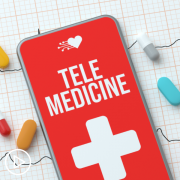
What Role Does Telemedicine Play in Acute Myeloid Leukemia Care? |
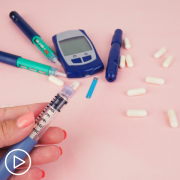
|

What Treatments Are on the Horizon for Acute Myeloid Leukemia Patients? |
Transcript:
Sasha Tanori:
After getting a bone marrow transplant three years later, I’m still dealing with graft-versus-host disease or GVHD, but there are other obstacles that I’m also facing. Does GVHD ever truly go away or is it something that I’m going to have to learn to live with?
Dr. Catherine Lai:
Yeah, I wish I had a magic answer for you. Our data is that it gives us guidance for each patient, but then also each patient as an individual and how they respond to different medications, and the nuances of that is…it can be different. So what I would say is that there are patients who you have chronic GVHD for years, and it can eventually go away. And in some patients, they deal with it for a lifetime, you’re young enough, and I’m hopeful enough that at some point it will improve and get better. So I would be cautiously optimistic that things will improve.



